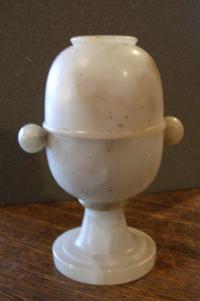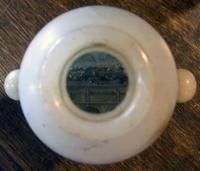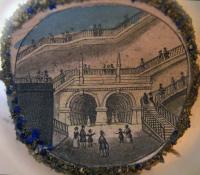The Graphic Arts collection holds a wide selection of optical toys and instruments, from a portable camera obscura to 20th-century Magic Mirror Movies. One of the favorite viewing devices in the Victorian era was affectionately known as the Peep Egg.
Unlike moving image viewers, such as the phenakistoscope or the zoetrope, this personal viewer allows one person to view one still image through a monocular lens. More complex peep shows or boite d’optique were equipped with many openings and/or moving parts to simulate daytime and nighttime. These viewing eggs were often made as souvenirs for a special event, festival, or exposition.
The peep egg is made of alabaster, so that light passes through the body of the device and no other source of illumination is required. The body is fitted with twin alabaster handles rotating a spindle so that two or three prints can be mounted inside the body of the egg. Each person turns the handle at his/her own speed to see each of the images. Princeton’s egg is from London and offers a hand-colored engraving of Greenwich Hospital, another of the Thames river at the entrance to the Tunnel, and a third panel in-between with a small bouquet of dried foliage and crystals.
One of many good websites showing optical devices is: http://users.telenet.be/thomasweynants/pre-cinema.index.html


